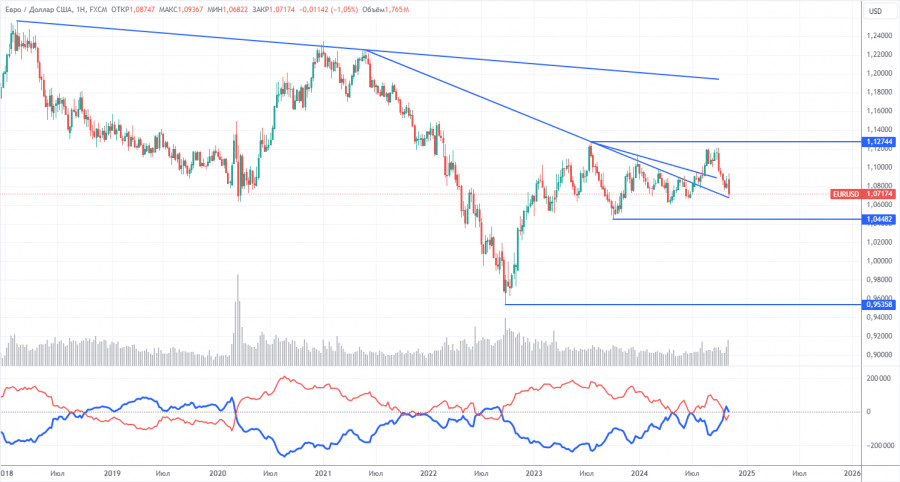EUR/USD 5-Minute Analysis
The EUR/USD pair continued its decline calmly on Tuesday, though calling this movement a "decline" may now seem insufficient. It is closer to a relentless collapse without corrections. While the euro isn't losing 100–150 pips daily, it has been steadily moving downward for a month and a half. For example, there weren't any significant reasons for a new drop in the euro on Monday or Tuesday. There were no notable macroeconomic reports or speeches by European Central Bank or Federal Reserve representatives capable of dramatically shifting the market. The euro continues to decline due to the reasons we've been highlighting since the beginning of the year. As a result, the price is approaching its initial target of around 1.0450.
This prolonged decline stems from the euro being overbought for too long while the market spent two years focusing solely on the anticipated easing of Fed monetary policy. We have repeatedly warned about this. What we see now is the aftermath of unjustified euro purchases. Additionally, it's worth noting that the upward movement over the past two years was merely a correction, and a new trend phase begins after a correction. The strength of the current movement indicates which phase is a correction and which is a trend.
We remain firmly supportive of the euro's further decline, as we predicted at the start of the year. Unlike other analysts, we strive to identify illogical movements, essentially market-maker manipulations. Yesterday, only one sell signal was formed when the price rebounded from the 1.0658–1.0669 zone. Fortunately, the price corrected back to this area, as the decline could have continued uninterrupted. Regardless, the short position was predictably profitable.
COT Report
The latest Commitments of Traders (COT) report is dated November 5. The net position of non-commercial traders has long remained bullish, with bears failing to gain dominance. However, three weeks ago, professional traders significantly increased their short positions, turning the net position negative for the first time in a long while. This indicates that the euro is now being sold more frequently than bought.
We still see no fundamental factors supporting the euro's strength, while technical analysis indicates consolidation—a flat market. On the weekly time frame, the pair has been trading between 1.0448 and 1.1274 since December 2022, effectively transitioning from a 7-month to a 20-month range. A move toward 1.0448 remains more likely.
Currently, the red and blue lines have crossed and reversed positions. Over the last reporting week, the number of long positions in the non-commercial group increased by 600, while short positions decreased by 28,000, resulting in a net drop of 27,400. The euro still has strong potential for further declines.
EUR/USD 1-Hour Analysis
The pair has resumed forming a new downtrend on the hourly time frame. There's no point in discussing the fundamental or macroeconomic basis for the dollar's medium-term decline—it simply doesn't exist. We anticipate nothing but further euro depreciation in the medium term. The market has fully priced in the Fed's monetary policy easing cycle and is now responding to other factors that point to a stronger dollar.
On November 13, we highlight the following levels for trading - 1.0530, 1.0581, 1.0658-1.0669, 1.0757, 1.0797, 1.0843, 1.0889, 1.0935, 1.1006, as well as the Senkou Span B (1.0810) and Kijun-sen (1.0716) lines. The lines of the Ichimoku indicator can move during the day, which should be considered when determining trading signals. Remember to place a Stop Loss order at breakeven if the price has gone in the intended direction for 15 pips. This will protect you from possible losses if the signal is false.
The U.S. will release its October inflation report on Wednesday, while the Eurozone's economic calendar remains empty. Market expectations for rising U.S. inflation suggest further strengthening of the dollar, especially if inflation surpasses current forecasts. However, if the forecast is met, a short-term correction upward is possible.
Chart Explanations:
Support and resistance levels: thick red lines around which movement may end. They are not sources of trading signals.
Kijun-sen and Senkou Span B lines: Ichimoku indicator lines transferred from the 4-hour to the 1-hour timeframe. These are strong lines.
Extreme levels: thin red lines where the price previously rebounded. They are sources of trading signals.
Yellow lines: Trend lines, trend channels, and other technical patterns.
Indicator 1 on COT charts: The net position size for each category of traders.













